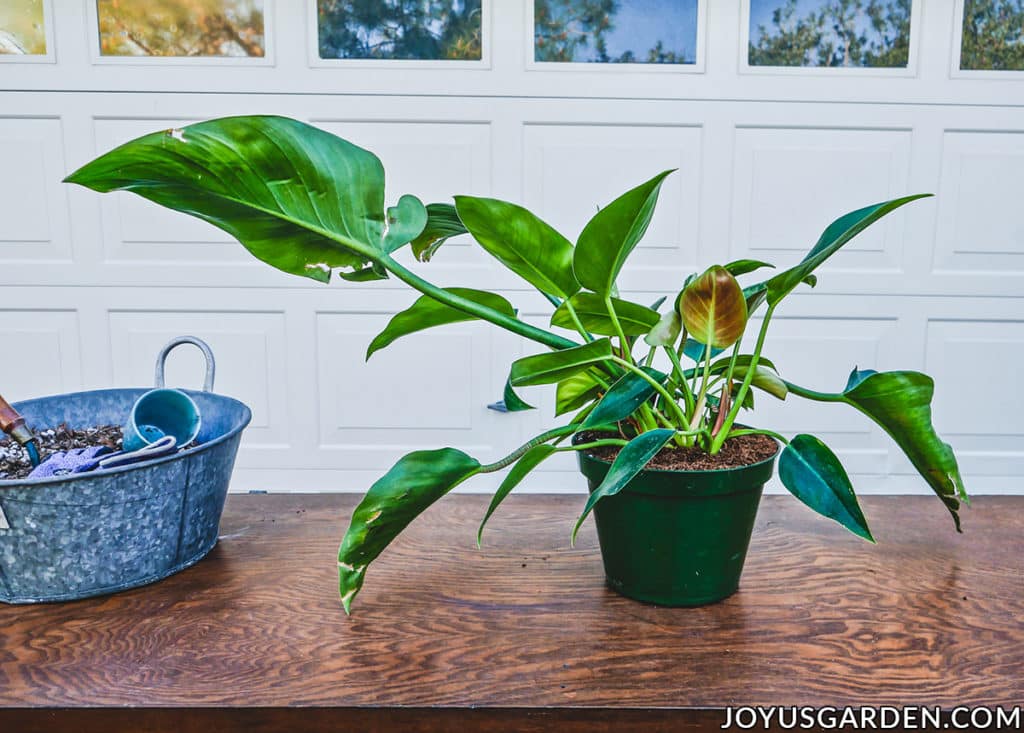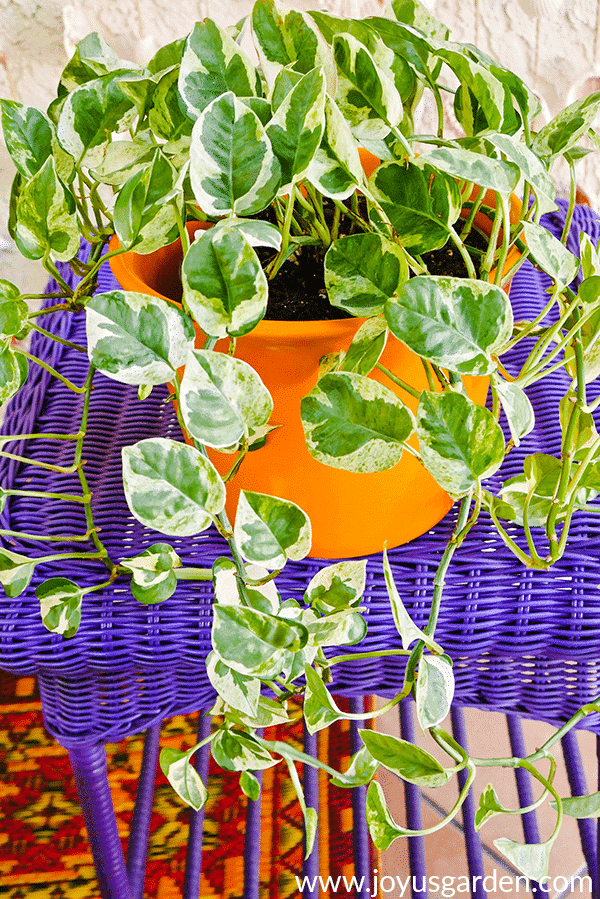Philodendron Congo Repotting: The Steps To Take & Mix To Use
Philodendrons are popular houseplants with a tropical vibe. Here are Philodendron Congo repotting tips with a homemade soil mix you can use plus things good to know.
I’m on a Philodendron roll these days. I seem to be amassing them just like Hoyas and Peperomias. One of my latest purchases was one I’d been looking for a while and was happy to find. This Philodendron Congo is growing like crazy and needs a new pot so I thought I’d share the process with you.
I’ve grown a Red Congo before but never the Green Congo. I bought this one in San Diego last summer along with a lot of other houseplants.
My car was jam-packed with foliage so a few of the leaves on this Congo got beat up on the drive through the desert. As the plant is growing and evening out (it’s definitely is lop-sided), I’m gradually cutting those large stems off.
Note: Everything below applies to the Philodendron Red Congo as well.
Time of year for Philodendron Congo repotting
Spring, summer, and into early fall are good times for repotting houseplants, Philodendrons included. If you live in a climate where winter comes early, then spring and summer are better.
Early fall is warm and sunny here in Tucson so I repot through the end of October.
It’s best to avoid repotting indoor plants in winter if you can because they like to rest during the cooler, darker months.
Related: Winter Houseplant Care
In case you’re wondering, I repotted this Philodendron Congo at the very end of March.

Pot Size
With smaller plants, I go up a pot size or two depending on what type I’m repotting and how fast it grows.
My Philodendron Congo was growing in a 6″ pot. I wasn’t sure what size pot I’d repot it into and wanted to see how the rootball looked after I got it out.
The roots were thick and wrapping around so I decided to put it in a 10″ pot. This will make a much more suitable base because the leaves and stems of this plant are on the heavy side. It definitely needed a more substantial base.
How often to repot a Philodendron Congo
It depends on the size of the plant and the pot, as well as the conditions it’s growing in. In general, every 2-4 years. We’re warm and sunny in the Arizona desert and most houseplants grow quickly here. I’ll most likely be repotting mine in 2 years.
Here are the 2 reasons I repotted my Philodendron Congo: some roots were appearing out of the drain holes, and it was heavier with foliage on one side which made it unable to stand up on its own. Those thick stems and large leaves add weight to the plant.

Materials used for the soil mix
Generally speaking, Philodendrons like a rich, somewhat chunky soil mix with a good dose of peat that drains well. You don’t want the roots to stay too wet otherwise they’ll rot out.
In nature, they grow on the bottom of the tropical rainforest floor and the mix listed below mimics the plant materials which fall on them from above and provide the nourishment they need.
The mix I created was roughly 1/2 potting soil and 1/2 coco coir (which is also called coco fiber). Coco coir is a more sustainable alternative to peat moss and has basically the same properties. I threw in a few handfuls of my DIY succulent & cactus mix (this has coco chips in it) for added drainage as well as a couple of compost for richness.
Use a potting soil that is peat-based and formulated for indoor plants. I alternate between Happy Frog and Ocean Forest, and sometimes I combine them. Both have lots of good stuff in them.
I topped it all with a 1/4″ layer of worm compost (for extra richness) and a layer of coco coir.
RELATED: How I Feed My Houseplants Naturally With Worm Compost & Compost
I have many plants (both indoors and outdoors) and do a lot of repotting so I have a variety of materials on hand at all times. Plus, I have plenty of room in my garage cabinets to store all the bags and pails.
If you have limited space, I give you a few alternative mixes suitable for Philodendron Congo repotting down below which consist of only 2 materials.
Alternative mixes
- 1/2 potting soil, 1/2 coco fiber or peat moss
- 1/2 potting soil, 1/2 orchid bark or coco chips
- 3/4 potting soil, 1/4 pumice or perlite
Some Of Our General Houseplant Guides For Your Reference:
- Guide To Watering Indoor Plants
- Beginner’s Guide To Repotting Plants
- 3 Ways To Successfully Fertilize Indoor Plants
- How to Clean Houseplants
- Winter Houseplant Care Guide
- Plant Humidity: How I Increase Humidity For Houseplants
- Buying Houseplants: 14 Tips For Indoor Gardening Newbies
- 11 Pet-Friendly Houseplants
How I repotted my Congo:
How to repot Philodendron Congo
I watered this plant the day before repotting it.
I put a single layer of newspaper over the drain holes to keep the fresh mix from running out with the 1st few waterings.
To get the plant out of the pot, I turned it sideways and pressed on the pot to loosen it. Sometimes you have to run a knife around the inside edge of the pot and/or give a good tug to get the plant out.
I filled the pot with enough mix so that the rootball would sit 1″ below the top of the pot. Fill in around the sides with more mix. I pressed on the rootball to make sure the plant was standing up straight.
I topped it all with a 1/4″ layer of worm compost (for extra richness) and a layer of coco coir.
RELATED: I’ve done a general Guide To Repotting Plants geared for beginning gardeners which you’ll find helpful.

Philodendron Congo Care after Repotting
It’s simple. Water your Philodendron well after the repotting/transplanting. I then put mine back in its bright spot in the dining room where it grows about 5′ away from a trio of east-facing windows.
You don’t want to let the soil completely dry out while the plant is settling in. How often you’ll water yours depends on these factors: the mix, the size of the pot, and the conditions it’s growing in.
It’s hot now in Tucson so I’ll probably water my newly repotted Phildoendron every 7 to 9 days until the weather cools. I’ll see how fast it’s drying out in the new mix and bigger pot but once a week or so sounds about right.
In the winter it’ll be every 2-3 weeks, maybe even less frequently. Just remember, even though the top of the soil is dry, it could be wet further down where the majority of the roots are. Those thick roots store water so keeping it too wet will eventually lead to root rot.
Related: Guide To Watering Indoor Plants

Philodendron Congo FAQs
Most of the Philodendrons I’ve repotted have been a bit root bound. They’ll do much better in the long run if those roots have room to spread out and grow.
In general, a mix with a good amount of peat moss or coco fiber in it.
It’ll exist in low light but won’t grow much if any. They prefer bright natural light with no hot, direct sun.
No, Philodendron Congos don’t climb. As a houseplant, their mature size is approximately 3′ x 3′.
You can put it outdoors for the summer but be sure to keep it out of direct sunlight. Be sure to bring it back indoors before the temps dip too low. It can grow outdoors in zones 10-11.

Philodendron Congo repotting isn’t hard to do. Fresh mix and a larger pot will help to keep your plant healthy, growing, and looking great.
Happy gardening,

Other houseplant repotting guides you may find helpful:





